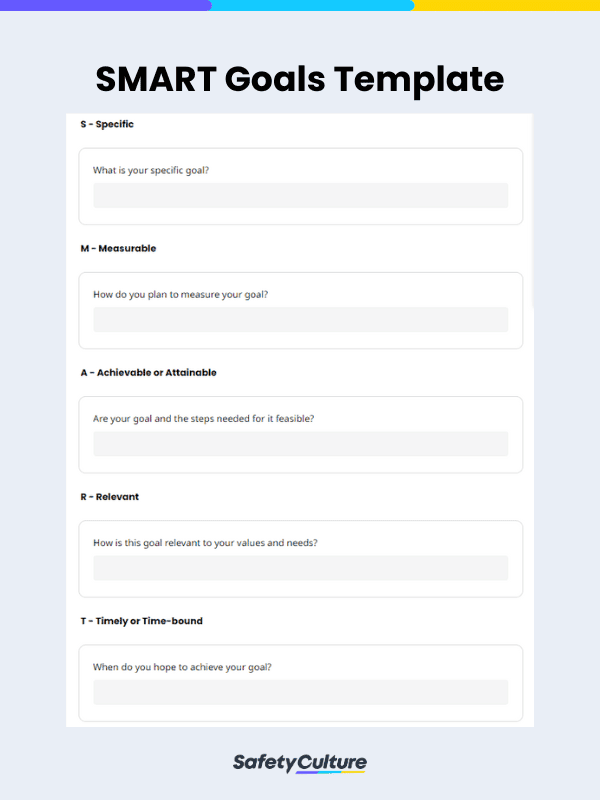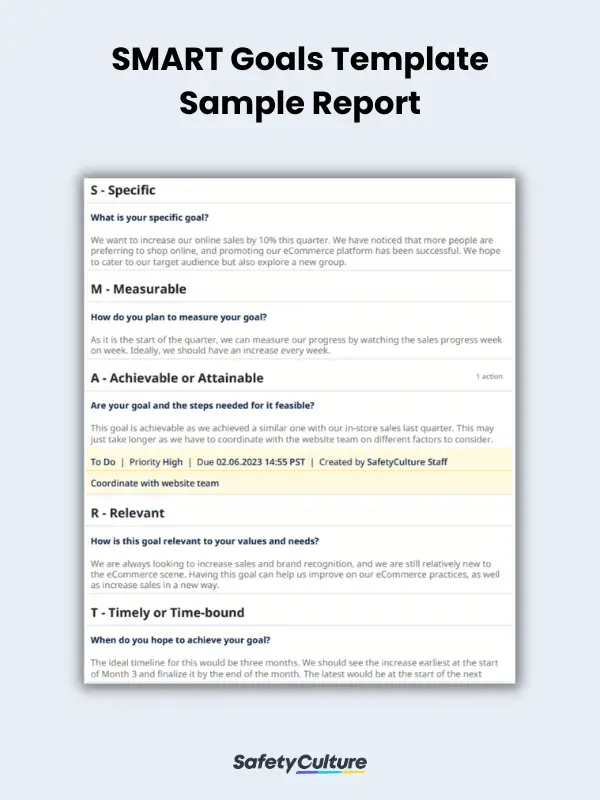What is a SMART Goals Template?
A SMART goals template is a premade document that can help you create goals that are Specific, Measurable, Achievable, Relevant, and Timely or Time-bound (SMART). You can use this to increase business profit, productivity, employee and customer satisfaction, and growth.
Purpose and Benefits
The main purpose of a SMART goals template is to help you create more realistic goals and manage them. With it, you can greatly simplify the process of setting and tracking goals and improve operational efficiency.
Using a SMART goals template can also help with the following:
- Providing structure for operations to better achieve goals
- Promoting consistency and standardization across teams and employees as the SMART goals template can help keep everyone on the same page
- Saving time and reducing waste in operations and processes as a template can streamline processes
- Encouraging accountability and transparency
- Tracking results and performing assessments
How to Create a SMART Goals Template
Create your own SMART goals template through the following steps:
#1 Define the Goal Area
Start by identifying the area or aspect of your operations that you want to focus on and improve. It could be about employee development, sales targets, project management, profit goals, or any other area that requires goal setting.
#2 Set Specific Goals
After identifying your focus, determine the specific objectives you want to achieve. Be clear and concise when articulating your goals, and evaluate their relevance in relation to your overall objectives, values, and priorities.
#3 Identify Measurable Indicators
Establish measurable indicators or metrics that will help you track progress and evaluate success. Quantify your goals whenever possible and keep track of them as they happen. Doing so allows for objective measurement and provides a benchmark for assessing your achievements.
#4 Assess Feasibility and Achievability
Consider the feasibility of your goals based on available resources, skills, and constraints. To ensure that your goals are realistic and attainable, assess the potential challenges you may face as you work towards your goals and determine if you have the necessary means to accomplish them.
#5 Set Time-Bound Deadlines
Assign specific deadlines or timeframes to your goals. Doing so creates a sense of urgency and promotes effective planning, progress monitoring, and contingency planning.
#6 Create the Template
Now that you have defined the components of your SMART goals, it’s time to create the template. Make it so it is easily reproducible, such as those created digitally. This will allow multiple people to use it all at once and ensure all goals are standardized in their creation and implementation.
However, you should also regularly review your SMART goals template to track progress, make adjustments, and update deadlines if needed. This ensures that your goals remain relevant and aligned with your evolving circumstances.
Training employees on the proper use of the SMART goals template and goal-setting is also an essential part of using and reviewing your template. With adequate training, you can better ensure your SMART goals are properly communicated and carried out.
How to Use a SMART Goals Template
The best way to fill out and use your SMART goals template is in order of Specific, Measurable, Achievable, Relevant, and Timely or Time-bound. When doing so, consider the following best practices:
Specific
Ensure that your goals are very clear and easy to understand. To ensure specificity, it should answer one, some, or all of the following:
- Who should be involved in achieving the goal?
- What exactly do you want to accomplish?
- When do you want to achieve your goal?
- Where should the goal be achieved, if applicable?
- Which items, obstacles, factors, or requirements should be taken into consideration?
- Why do you want to achieve this goal?
Measurable
After listing your specific goal or goals, write down how you plan to measure your progress. Here, you can better reword your goal to include your metrics or list down the metrics themselves.
Measurable goals have quantifiable criteria that allow progress to be objectively tracked. By including specific metrics or indicators, you can determine whether you’re making progress toward your goal.
Achievable
Also sometimes called “Attainable,” this is the section where you evaluate the feasibility of your goal and the steps you want to take toward it.
Relevant
Although the relevancy of your goal to your overall business need should have been determined in the process of creating it, it is important to disclose the reason for your goal. Further evaluate how your goals are relevant to your business and other objectives here.
Timely or Time-bound
Before officially carrying out the necessary steps to achieve your goal, create a timeline for your process. Set a realistic deadline for your goal while considering all other factors mentioned so far and analyze how feasible it can be.
Here is a sample SMART goals template in use for reference:
FAQs about SMART Goals Templates
High-level leaders are typically in charge of creating SMART goals and using the proper documents for them. It is their responsibility to cascade this down to other employees and involve them in the creation process.
Yes, a SMART goals template can be used for goals outside of a business. SMART goals are a methodology that can be adopted by anyone and in any setting where they need to establish targets, including students, professionals, teams, and other groups.
You can use SMART goals to set goals for the following:
- Increase in sales
- Project management
- Employee growth



